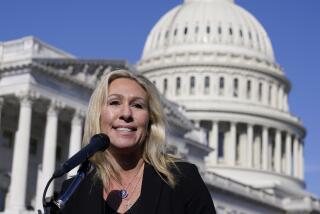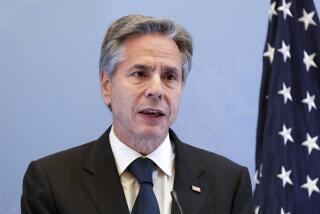Bush OKs Obama’s request for $350-billion balance of bailout fund
WASHINGTON — In formally asking Monday for the release of the second half of the $700-billion financial bailout fund, President-elect Barack Obama is promising Congress he will do a better job than President Bush in using the money to help average Americans.
“We’re going to focus on housing and foreclosures. We’re going to focus on small businesses,” Obama told reporters Monday. “We’re going to focus on what’s required to make sure that credit is flowing to consumers and businesses to create jobs in the United States.”
But first Obama must focus on smoothing over strong resentment on Capitol Hill about the Troubled Asset Relief Program, or TARP. Many Democrats and Republicans say they were misled by Treasury Secretary Henry M. Paulson about how the first $350 billion would be spent. Democrats are particularly angry that none of the money has gone to help homeowners facing foreclosure.
“People feel they got burned up here by the current administration,” said Senate Budget Committee Chairman Kent Conrad (D-N.D.). “I understand the need for the money to be released. I also feel very strongly it’s got to be conditioned in a way to avoid what I see are the abuses by the administration in the handling of the first” half.
The Democratic-controlled Congress is unlikely to block the request. But Obama is seeking to avoid a confrontation over economic recovery spending that could spill into his push for a roughly $800-billion stimulus package.
Lawrence H. Summers, whom Obama has chosen to head his National Economic Council, promised in a three-page letter to congressional leaders Monday that the new administration would “act both quickly and wisely.” He broadly outlined the changes that Obama was planning for the second part of the fund, including more transparency in how the money is spent and “a sweeping effort” to reduce foreclosures.
“We cannot allow the failures of the past to prevent us from doing what we must to secure America’s future,” Summers wrote to House Speaker Nancy Pelosi (D-San Francisco), House Minority Leader John A. Boehner (R-Ohio), Senate Majority Leader Harry Reid (D-Nev.) and Senate Minority Leader Mitch McConnell (R-Ky.)
Obama worked behind the scenes to soothe lawmakers. On Monday morning, for example, he twice phoned Sen. Barbara Boxer (D-Calif.), who does not even serve on any of the relevant committees. Boxer, like many senators and representatives, has been upset with the bailout fund’s administration.
“I don’t like the way Paulson handled this. And I said if we don’t get involved in trying to solve this housing crisis, then we’re never going to” alleviate the problem, Boxer said she told Obama after leaving a meeting with reporters in her office two times to field his calls.
“He agreed with that. . . . He’s going to lay out what he feels the money is needed for, and that [housing] would be one of the things it’s needed for.”
Boxer said she wanted Obama to make those commitments publicly.
Conrad echoed that view.
“I think it’s going to take more than a letter from Mr. Summers to assure people this money is going to be used in a way that is appropriate and is in line with congressional intent,” he said. “It’s going to take those who have responsibility for actually spending the funds to put in writing their intentions.”
House Financial Services Committee Chairman Barney Frank (D-Mass.) will hold a hearing today on legislation that would force major changes in the TARP program, including a requirement that $40 billion to $100 billion of the remaining money be used to revise existing mortgages to avoid foreclosures. In introducing the bill Friday, he said Democrats “intend to trust, but verify” Obama’s use of the final $350 billion in the fund.
Frank said Monday that the money “could be made available under the appropriate conditions” and that Obama seemed to agree with his proposals.
Boehner and some other Republicans said Monday that they would oppose releasing the final half of the bailout fund. But Reid and Pelosi indicated that they were willing to work with Obama to release the money.
Obama has said he shares congressional anger over the Bush administration’s handling of the TARP money. But he said he needed access to the remaining $350 billion to be able to respond quickly to any new crises.
“It is clear that the financial system, although improved from where it was in September, is still fragile, and I felt that it would be irresponsible for me . . . to enter into the administration without any potential ammunition should there be some sort of emergency or weakening of the financial system,” Obama told reporters Monday.
He called Bush on Monday morning and asked him to notify Congress to access the second half of the fund. Bush agreed, and a formal request was delivered to Congress on Monday night.
Under the bailout legislation that cleared Congress last fall, lawmakers must pass a formal “resolution of disapproval” within 15 days of receiving the request; otherwise, the money will be released automatically. Bush or Obama could veto such a resolution. Congress could overturn the veto with a two-thirds vote of the House and Senate.
Many lawmakers are upset that Paulson did not use the money to buy troubled mortgage-backed securities from banks and other institutions, as he had initially indicated he would. Instead, Paulson used flexibility in the legislation to pump most of the funds into banks in exchange for equity stakes in hopes of loosening the flow of credit. But for the most part, banks have not lent the money.
About $250 billion has been allocated to buy equity in banks, with half going to the nation’s nine largest institutions, including Bank of America Corp. and Wells Fargo & Co., and the rest to more than 200 others. Insurance giant American International Group Inc. received $40 billion as part of a larger government bailout, and Citigroup Inc. received $20 billion.
In addition, $20 billion was used to help back a Federal Reserve initiative for consumer asset-backed securities. And General Motors Corp. and Chrysler received $13.4 billion in emergency loans.
Congress also gave Paulson authority to use some of the funds to help homeowners facing foreclosure, but he has not done so.
Paulson defended the administration’s handling of the fund Monday. He told CNBC that there had been “great transparency” and that it was right to make direct injections of money into banks instead of buying mortgage-backed securities.
But a congressional panel set up to monitor TARP criticized the Treasury Department on Friday for lack of information about how the banks were using the money and other details about the program.
--
More to Read
Sign up for Essential California
The most important California stories and recommendations in your inbox every morning.
You may occasionally receive promotional content from the Los Angeles Times.











